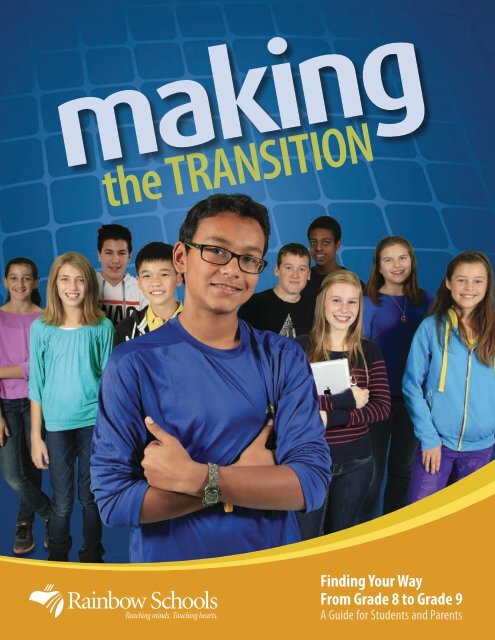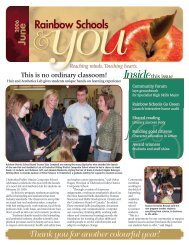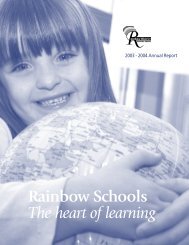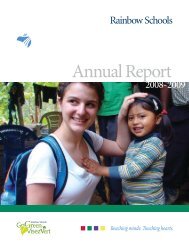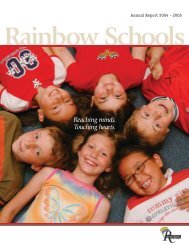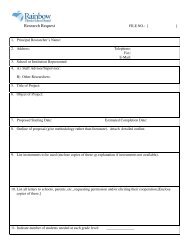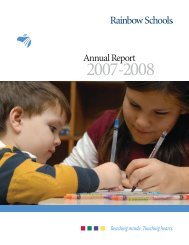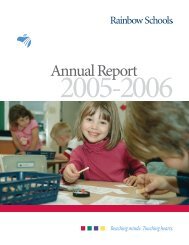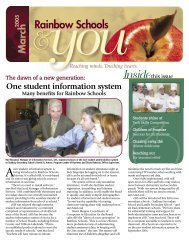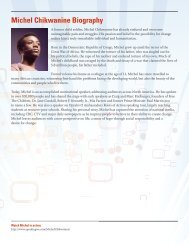Transition Guide - Rainbow District School Board
Transition Guide - Rainbow District School Board
Transition Guide - Rainbow District School Board
Create successful ePaper yourself
Turn your PDF publications into a flip-book with our unique Google optimized e-Paper software.
making<br />
the TRANSITION<br />
Finding Your Way<br />
From Grade 8 to Grade 9<br />
A <strong>Guide</strong> for Students and Parents<br />
<strong>Rainbow</strong> <strong>School</strong>s | Reaching minds. Touching hearts. 1
our future<br />
begins here!<br />
Inside<br />
3 Secondary school<br />
terms and definitions<br />
4 Decoding a course<br />
code and timetable<br />
5 Ontario Secondary<br />
<strong>School</strong> Diploma<br />
6 Selecting courses<br />
7 Programs<br />
and resources<br />
8 How parents can help<br />
9 Learning skills<br />
10 Ensuring success<br />
11 Tips from secondary<br />
school students<br />
This publication was produced by<br />
the <strong>Rainbow</strong> <strong>District</strong> <strong>School</strong> <strong>Board</strong><br />
Parent Involvement Committee<br />
with funding from the Ministry of<br />
Education Parent Engagement Office.<br />
Welcome to secondary school,<br />
a new and exciting time in your life where endless<br />
opportunities and pathways are yours to discover.<br />
Throughout this journey, caring teachers and<br />
supportive school administrators will work with<br />
you to help you maximize your potential and<br />
fulfill your aspirations.<br />
As a secondary school student, you will<br />
have important choices to make that<br />
will open doors for your future. You will<br />
also be given opportunities to gain<br />
hands-on experience and explore<br />
careers of interest.<br />
This guide will help you along<br />
the way. It contains information<br />
about course codes, pathways,<br />
timetables and tips.<br />
This guide will also be of<br />
benefit to parents/guardians,<br />
our partners in the learning process.<br />
Parental involvement improves student<br />
achievement and we thank parents/guardians<br />
for supporting their children as they make<br />
the transition into secondary school.<br />
In <strong>Rainbow</strong> <strong>School</strong>s, we are committed to<br />
giving students every opportunity to achieve<br />
success in learning and life.<br />
2<br />
Your future begins here.<br />
Enjoy the journey!<br />
Making the <strong>Transition</strong> | Finding Your Way From Grade 8 to Grade 9
<strong>Rainbow</strong> <strong>School</strong>s | Reaching minds. Touching hearts.<br />
Community Service Hours<br />
Students must complete 40 community<br />
service hours, at any time in secondary<br />
school, as part of their Ontario Secondary<br />
<strong>School</strong> Diploma (OSSD) requirements.<br />
Compulsory Course<br />
This is a specific course students must take<br />
that fulfills part of the Ontario Secondary<br />
<strong>School</strong> Diploma (OSSD) requirements.<br />
Course Code<br />
This six-character code describes the<br />
subject, grade level and stream or<br />
destination of a secondary school course.<br />
Credit<br />
A credit value of 1.0 is granted upon<br />
successfully completing a 110-hour course<br />
with a minimum of 50%.<br />
Culminating Activity<br />
Students may be asked to complete a<br />
course culminating activity, which is a major<br />
project<br />
for each<br />
course.<br />
There are<br />
a variety of<br />
assessment practices<br />
that teachers may<br />
use to address the individual<br />
learning styles of all students.<br />
Education Quality and<br />
Accountability Office (EQAO)<br />
Literacy Test<br />
The literacy test is written in Grade 10.<br />
A student must pass the literacy requirement<br />
to earn the OSSD. The purpose of this test is<br />
to ensure that students have acquired the<br />
essential reading and writing skills that apply<br />
to all subject areas in and up to the end of<br />
Grade 9.<br />
Grade 9 Assessment of Mathematics<br />
The Grade 9 Assessment of Mathematics<br />
provides individual and system data on<br />
student knowledge and skills based on the<br />
curriculum expectations in Grade 9 applied<br />
and academic programs. All students in<br />
these programs are required to participate.<br />
Exams<br />
Students may write an exam, which tests<br />
their knowledge on the entire course work,<br />
at or near the end of the semester.<br />
Optional Courses<br />
Students will select 12 courses that<br />
are of specific interest to them and<br />
which will count towards the 30-credit<br />
OSSD requirement.<br />
Ontario Secondary<br />
<strong>School</strong> Diploma (OSSD)<br />
The Ontario Secondary <strong>School</strong> Diploma is<br />
granted after fulfilling all necessary credit,<br />
literacy and community hour requirements.<br />
Prerequisite Course<br />
This is a specific course students must<br />
successfully complete before taking<br />
another course at the next grade level.<br />
Semester<br />
The school year is divided into two<br />
semesters. A student will take four courses<br />
in each semester.<br />
Student Success<br />
Secondary schools have staff and programs<br />
in place to support and improve student<br />
learning.<br />
Timetable<br />
A timetable outlines the course, time,<br />
room number, lunch period, teacher and<br />
semester in which students will take all<br />
of their courses.<br />
3
Decoding<br />
A Course Code<br />
Courses use a six-character<br />
course code for identification.<br />
The first five characters of the course<br />
code are set out by the Ministry of<br />
Education. The sixth character is used<br />
by school boards to identify a<br />
specific characteristic of the course,<br />
for example, Co-operative Education.<br />
A Timetable<br />
Semester 1:<br />
September - January<br />
Period 1 /<br />
Homeroom:<br />
Approximately<br />
15 minutes longer<br />
to allow for morning<br />
announcements.<br />
Class Time:<br />
75 minutes<br />
with 3 minutes<br />
travel time<br />
4 Making<br />
ENG 1 D 1<br />
Period Time Subject<br />
1 8:45 am<br />
to 10:04 am<br />
English<br />
ENG1D1-01<br />
Atwood, M. | 203<br />
2 10:07 am<br />
to 11:21 am<br />
Mathematics<br />
MFM1P1-03<br />
Descartes, R. | 105<br />
Lunch 11:21 am to 12:14 pm<br />
3 12:14 pm<br />
to 1:28 pm<br />
Art<br />
AV1101-01<br />
Da Vinci, L. | 105<br />
4 1:31 pm<br />
to 2:45 pm<br />
Geography<br />
CGC1D1-04<br />
Cabot, J. | 215<br />
This school identifier is used to distinguish course characteristics.<br />
1 = Common M = Male<br />
code F = Female<br />
This letter identifies the course type<br />
for Grades 9-10:<br />
D = Academic L = Locally Developed<br />
P = Applied O = Open<br />
This number identifies the grade:<br />
1 = Grade 9 3 = Grade 11<br />
2 = Grade 10 4 = Grade 12<br />
These three letters identify the subject.<br />
Subject codes: The first letter in the course<br />
code denotes the course’s department area.<br />
A = Arts<br />
B = Business<br />
C = Canadian and World Studies<br />
E = English<br />
F = French<br />
G = Guidance and<br />
Career Education<br />
H = Humanities and<br />
Social Sciences<br />
L = International Languages<br />
M = Mathematics<br />
P = Physical Education<br />
S = Science<br />
T = Technology<br />
Course Credit<br />
Students take<br />
4 credits in<br />
each semester.<br />
Course Code<br />
and Section<br />
Course and specific class<br />
Teacher’s Name<br />
Room Number<br />
the <strong>Transition</strong> | Finding Your Way From Grade 8 to Grade 9
What do I need to graduate?<br />
Ontario Secondary <strong>School</strong> Diploma<br />
The OSSD is the diploma that students work towards<br />
achieving in high school. Every <strong>Rainbow</strong> <strong>District</strong> <strong>School</strong> <strong>Board</strong><br />
secondary school student must successfully complete the<br />
following requirements:<br />
• 30 credits - 18 compulsory and 12 optional<br />
• Ontario Secondary <strong>School</strong> Literacy Requirement<br />
• 40 Community Service Hours<br />
What you should know...<br />
How do I earn a credit?<br />
You must earn a final grade of 50% or more in a course<br />
to earn a credit.<br />
How many credits can I earn each year?<br />
The table below outlines a typical student’s credits<br />
and credit totals year by year.<br />
Yearly Grade 9 Grade 10 Grade 11 Grade 12<br />
Credits 8 8 8 6 - 8<br />
Totals 8 16 24 30 - 32<br />
What will happen if I fail the literacy test?<br />
You will be given opportunities to repeat the test<br />
or take the Ontario Secondary <strong>School</strong> Literacy<br />
Course in its place.<br />
When can I start to earn my 40 hours<br />
of community service?<br />
• After graduating from Grade 8.<br />
• Community service hours must not be<br />
scheduled during class time.<br />
What happens if I fail a course?<br />
You need to meet with your guidance<br />
counsellor or student success teacher to<br />
explain the following options that might<br />
be available to you:<br />
• Repeating the course the next semester.<br />
• Completing the course at Summer <strong>School</strong>.<br />
• Recovering the credit in Credit Recovery.<br />
Ontario Secondary <strong>School</strong> Diploma<br />
18 Compulsory Credits Credits<br />
Credits Required Earned<br />
q7<br />
English (1 per grade) 4 q q q q<br />
Math (at least 1 in Grades 11 or 12) 3 q q q<br />
Science 2 q q<br />
French (Grade 9) 1 q<br />
Canadian Geography (Grade 9) 1 q<br />
Canadian History (Grade 10) 1 q<br />
The Arts 1 q<br />
Health and Physical Education 1 q<br />
Civics (Grade 10) 0.5 q<br />
Careers (Grade 10) 0.5 q<br />
Group 1 - Choose one from... 1 q<br />
A Third Language<br />
Humanities and Social Sciences<br />
Canadian and World Studies<br />
Guidance and Career Education<br />
Co-operative Education*<br />
Group 2 - Choose one from... 1 q<br />
Additional Health and Physical Education<br />
Additional Arts<br />
Business<br />
Co-operative Education*<br />
Group 3 - Choose one from... 1 q<br />
Additional Science (Grades 11 or 12)<br />
Technology (Grades 9 - 12)<br />
Co-operative Education*<br />
*Note: A maximum of two Co-operative Education credits can be used<br />
to fulfill compulsory requirements under Group 1, 2 or 3.<br />
Optional Credits 12 q q q q<br />
q q q q<br />
q q q q<br />
Literacy Requirements<br />
Ontario Secondary <strong>School</strong> Literacy Test<br />
q<br />
Taken in Grade 10<br />
Community Service Hours Requirements<br />
40 Hours completed over 4 years q<br />
<strong>Rainbow</strong> <strong>School</strong>s | Reaching minds. Touching hearts.<br />
5
Which one<br />
do I choose?<br />
Academic, Applied or Locally Developed<br />
You will be asked to select a course type for Grade 9<br />
compulsory courses (English, French, geography, math and<br />
science). Read the information below to get a better idea<br />
of what course type is best for you. If you are uncertain,<br />
get help from your teacher or the guidance department.<br />
They will be able to advise you.<br />
Course Types<br />
Academic “D”<br />
Students will learn the essential concepts of a subject and<br />
explore related materials. Emphasis will be on theory and<br />
abstract thinking as a basis for future learning. Students<br />
should be working consistently at or above Level 2+, 3<br />
or 4 in Grade 8. Students should be independent learners<br />
with learning skills at the “good” to “excellent” level.<br />
Applied “P”<br />
Students will learn the essential concepts of a subject.<br />
Emphasis will be on the practical and hands-on<br />
applications of the concepts. Students should be working<br />
consistently at Level 1+, 2- or 2 in Grade 8. Students are<br />
generally more dependent learners and require greater<br />
teacher direction and instruction.<br />
Locally Developed Courses “L”<br />
Students will learn the most essential concepts of a<br />
subject. <strong>School</strong> staff generally recommend these courses<br />
for students with specific learning needs. Students should<br />
be working consistently at Level 1 or below in Grade 8.<br />
Students require greater teacher direction and instruction<br />
to accommodate learning needs.<br />
Open Courses “O”<br />
Students will learn concepts and skills designed to prepare<br />
for further study in the subject area. Expectations are<br />
designed and appropriate for all students. Generally,<br />
the optional courses (such as physical education, art, etc.)<br />
are offered in the open courses. Students can have a variety<br />
of learning skills.<br />
6 Making<br />
Q&<br />
A<br />
Am I locked into a course<br />
or can I switch if I need to?<br />
Yes. You can change course types. In math, if you wish<br />
to move into Grade 10 academic, you must successfully<br />
complete a half credit transfer course. In all other courses,<br />
changes can be made without compulsory course work. If the<br />
academic course proves to be too challenging, it is possible to<br />
switch to the applied or locally developed courses.<br />
Is there somewhere or someone I can<br />
go to for help if I have questions about<br />
course selection?<br />
Yes. Your classroom teacher can assist you with selecting<br />
courses. You can also attend the <strong>Rainbow</strong> secondary school<br />
information evenings for assistance or call a <strong>Rainbow</strong><br />
secondary school for more information. Don’t forget that<br />
your parents/guardians will also be helpful in providing<br />
advice and assisting you with your planning.<br />
Do all the courses I select have to be the same<br />
- academic, applied or locally developed?<br />
No. You are encouraged to take the one that best suits your<br />
needs and/or abilities. You can select a variety of courses.<br />
I have been studying in a French Immersion<br />
Program throughout elementary school.<br />
Can I continue to take French Immersion<br />
courses in secondary school?<br />
Yes. A variety of French Immersion courses are offered at<br />
select secondary schools. Students may obtain a French<br />
Immersion Certificate upon graduation by completing a<br />
minimum of ten courses taught in French.<br />
the <strong>Transition</strong> | Finding Your Way From Grade 8 to Grade 9
How do I know<br />
if my child is at risk?<br />
Definition of “at risk’’<br />
According to the Ministry of Education, the following students may be considered<br />
at risk of not being successful in their courses, which significantly reduces their<br />
chances of graduating:<br />
• Elementary students who are<br />
performing at level 1 or below<br />
grade expectation.<br />
• Secondary students who are<br />
performing significantly below the<br />
provincial standard, earning marks<br />
in the 50s or low 60s, and who do not<br />
have the foundations to be successful<br />
in the new curriculum.<br />
Did you know?<br />
• Students who fail one course in Grade 9<br />
significantly decrease their chances of graduating.<br />
• Students who miss three or more days a month<br />
are considered at risk of not being successful.<br />
• Students who are disengaged<br />
from classes for a variety of reasons,<br />
which tend to be reflected in<br />
poor attendance.<br />
• Students who are skipping classes.<br />
• Students who are performing poorly<br />
on assessments.<br />
How schools<br />
can help students<br />
Secondary schools have a variety<br />
of programs and resources available<br />
to students to ensure their success:<br />
• Homework clubs that take place at lunch<br />
and/or after school<br />
• Homework websites posted by individual<br />
teachers for students to access daily homework<br />
assignments and due dates<br />
• Peer helper programs<br />
• Additional one-on-one assistance<br />
from classroom teachers<br />
• Summer <strong>School</strong> programs<br />
• Credit Recovery programs<br />
• Student Success Teacher support<br />
• Guidance Counsellor support<br />
• Attendance Counsellor support<br />
• Social Workers<br />
What parents need to know…<br />
Find out what is available to you and your child to ensure success in secondary school.<br />
Six ways to succeed:<br />
1. Co-operative Education -<br />
The Co-operative Education<br />
Program integrates classroom<br />
theory with practical experience.<br />
Students divide their time between<br />
the school and the workplace.<br />
2. Ontario Youth Apprenticeship<br />
Program (OYAP) - This Co-operative<br />
Education Program gives senior<br />
students an opportunity to begin<br />
a career in a skilled trade while<br />
attending high school.<br />
3. Dual Credit Programs -<br />
Students can earn credits that can<br />
be applied towards both their<br />
secondary school diploma and their<br />
postsecondary diploma, degree or<br />
apprenticeship certification.<br />
4. Specialist High Skills Major<br />
(SHSM) - The Specialist High Skills<br />
Major (SHSM) is a specialized,<br />
Ministry of Education approved<br />
program that allows students to<br />
focus their learning on a specific<br />
economic sector while meeting<br />
the requirements of the Ontario<br />
Secondary <strong>School</strong> Diploma (OSSD).<br />
SHSMs assist students in their<br />
transition from secondary school<br />
to apprenticeship training, college,<br />
university or the workplace.<br />
5. Student Success Teams -<br />
Each secondary school has a<br />
dedicated team that supports<br />
students to ensure they earn the<br />
credits they need to graduate.<br />
<strong>Rainbow</strong> <strong>School</strong>s are committed to ongoing communication with parents/guardians regarding student progress.<br />
<strong>Rainbow</strong> <strong>School</strong>s | Reaching minds. Touching hearts.<br />
6. Grade 8 to Grade 9 <strong>Transition</strong> -<br />
Elementary and secondary teachers<br />
work together to ease the transition,<br />
through special information nights for<br />
students/parents, transition activities<br />
in secondary schools, more dialogue<br />
between teachers in both panels,<br />
increased professional learning to<br />
share best practices and improved<br />
tracking of students and their progress.<br />
7
Parents can help students be<br />
successful in secondary school<br />
by doing the following:<br />
n Be aware of your child’s strengths and<br />
weaknesses. This will allow you to help your<br />
child choose the appropriate courses.<br />
n Closely monitor your child’s attendance.<br />
Continue to notify the school should<br />
your child be absent from school.<br />
n Communicate with your child’s teachers<br />
on a regular basis.<br />
n Closely monitor your child’s progress.<br />
• Report card cycle:<br />
- Interim reports are distributed<br />
in October and March<br />
- Mid-term reports are distributed<br />
in November and April<br />
- Final reports are distributed<br />
in February and July<br />
- Parent/teacher interviews are<br />
typically held in October and March<br />
n Many schools now have monthly<br />
progress reports.<br />
n Be aware that your child will typically<br />
have four teachers per semester.<br />
n Know who to turn to for answers.<br />
Support for students in secondary<br />
school includes:<br />
• Student Success Teachers<br />
• Guidance Counsellors<br />
• Special Education Teachers /<br />
Educational Assistants<br />
• Vice-Principals and Principals<br />
8 Making<br />
the <strong>Transition</strong> | Finding Your Way From Grade 8 to Grade 9
Six important learning skills necessary<br />
for student success<br />
Striving to be successful in each learning skill<br />
will ensure overall academic success.<br />
<strong>Rainbow</strong> <strong>School</strong>s | Reaching minds. Touching hearts.<br />
Responsibility<br />
Fulfills responsibilities and commitments<br />
within the learning environment<br />
Completes and submits class work,<br />
homework and assignments according<br />
to agreed-upon timelines<br />
Takes responsibility for and manages<br />
own behaviour<br />
Organization<br />
Devises and follows a plan<br />
and process for completing<br />
work and tasks<br />
Establishes priorities and<br />
manages time to complete<br />
tasks and achieve goals<br />
Identifies, gathers, evaluates<br />
and uses information,<br />
technology and resources<br />
to complete tasks<br />
Independent Work<br />
Monitors, assesses and<br />
revises plans independently to<br />
complete tasks and meet goals<br />
Uses class time appropriately<br />
to complete tasks<br />
Follows instructions with<br />
minimal supervision<br />
Collaboration<br />
Accepts various roles and an equitable<br />
share of work in a group<br />
Responds positively to the ideas, opinions,<br />
values and traditions of others<br />
Builds healthy peer-to-peer relationships<br />
through personal and media-assisted<br />
interactions<br />
Works with others to resolve conflicts<br />
and build consensus to achieve group goals<br />
Shares information, resources and<br />
expertise and promotes critical thinking<br />
to solve problems and make decisions<br />
Initiative<br />
Looks for and acts on new ideas<br />
and opportunities for learning<br />
Demonstrates the capacity for innovations<br />
and a willingness to take risks<br />
Demonstrates curiosity and interest<br />
in learning<br />
Approaches new tasks with<br />
a positive attitude<br />
Recognizes and advocates appropriately<br />
for the rights of self and others<br />
Self-Regulation<br />
Sets own individual goals and monitors<br />
progress towards achieving them<br />
Seeks clarification or assistance<br />
when needed<br />
Assesses and reflects critically<br />
on own strengths, needs and interests<br />
Identifies learning opportunities, choices<br />
and strategies to meet personal needs<br />
and achieve goals<br />
Perseveres and makes an effort<br />
when responding to challenges<br />
9
Ensure #success<br />
10<br />
Making<br />
As parents, you can focus on a few key areas<br />
that can positively impact your child’s<br />
opportunity for #success.<br />
A few examples include:<br />
#Attendance<br />
Recommendations<br />
• Students attend school each day.<br />
• Students arrive to class on time.<br />
Warning Signs<br />
• Your child is missing school more than 10% of the time.<br />
• Your child’s report card shows more absences than you expected.<br />
Strategies<br />
• Discuss your child’s attendance record with the school<br />
administration and plan to ensure regular attendance.<br />
• If your child is absent, ensure missed work<br />
is completed and submitted.<br />
#Organization and time management<br />
Recommendations<br />
• Students are taking accurate notes and keeping binders<br />
well organized.<br />
• Students are using an agenda to plan for assignment<br />
completion and evaluations.<br />
Warning Signs<br />
• Your child does not have or use an agenda.<br />
• Your child’s notebooks are disorganized and appear incomplete.<br />
Strategies<br />
• Obtain an agenda for your child.<br />
• Monitor the use of the agenda and notebooks.<br />
#Homework and submission of assignments<br />
Recommendations<br />
• Grade 7-9 students should spend 45 to 90 minutes<br />
on daily homework.<br />
• Grade 10-12 students should spend 1.5 to 3 hours<br />
on daily homework.<br />
Warning Sign<br />
• If you do not see your child doing homework regularly or<br />
your child says “I don’t have any homework” on a regular basis.<br />
Strategies<br />
• Contact the school or teacher and get informed about<br />
the situation.<br />
• A student should be reading and studying<br />
for the time recommended each day.<br />
the <strong>Transition</strong> | Finding Your Way From Grade 8 to Grade 9
#tips from secondary school<br />
students<br />
Money<br />
Each school will charge a voluntary student activity fee which covers<br />
many student activities planned throughout the year. Fees may also be<br />
charged for participation in some courses, clubs and school teams to<br />
cover extraordinary costs.<br />
#tip: Keep extra change in your locker for unexpected purchases,<br />
such as a snack from the cafeteria or the need to use the pay phone.<br />
Be prepared<br />
Obtain general school supplies during the summer. Teachers will let you know<br />
if you need specific course supplies on the first day of class.<br />
#tip:<br />
Exchange phone numbers with a class buddy who can pick up notes<br />
or homework for you if you are absent from school.<br />
Getting good grades<br />
Getting good grades is easier if you follow these tips from students.<br />
#tips: • Attend and participate in all classes.<br />
• Plan a regular time to study each evening.<br />
• Balance recreational activities<br />
with school work.<br />
Locks/lockers and books<br />
You will be given your own lock and locker. Keep your<br />
lock combination a secret to protect the belongings you<br />
have in your locker.<br />
#tip: You don’t need to carry all your books for the day<br />
at all times. Store some in your locker and return to your<br />
locker during the day to exchange books.<br />
Relationships<br />
Building positive relationships with your teachers and classmates will<br />
make school a great place - one that is more than just books and classes.<br />
#tips: • Build new friendships by joining clubs and teams.<br />
You will be happy you did.<br />
• Know when teachers offer extra help or ask them<br />
for help when needed.<br />
Transportation<br />
If you are eligible for busing, find out your travel arrangements prior to school<br />
by contacting the Sudbury Student Services Consortium at 705.521.1234 or<br />
1.877.225.1196. Visit the Consortium website at businfo.ca.<br />
#tip: Have a back up plan to get to and from school in case your regular<br />
travel arrangements fall through. If you participate in after school<br />
activities, you will need to make your own travel arrangements<br />
to get home.<br />
<strong>Rainbow</strong> <strong>School</strong>s | Reaching minds. Touching hearts.<br />
11
Where you belong.<br />
Secondary <strong>School</strong>s<br />
Chelmsford Valley <strong>District</strong><br />
Composite <strong>School</strong><br />
3594 Highway 144, Chelmsford<br />
705.675.0225<br />
Confederation<br />
Secondary <strong>School</strong><br />
1918 Main Street West, Val Caron<br />
705.671.5948<br />
Lasalle Secondary <strong>School</strong><br />
1545 Kennedy Street, Sudbury<br />
705.566.2280<br />
Lively <strong>District</strong><br />
Secondary <strong>School</strong><br />
<strong>School</strong> of Integrated Technology<br />
265 Fifth Avenue, Lively<br />
705.692.3671<br />
Lo-Ellen Park<br />
Secondary <strong>School</strong><br />
International Baccalaureate Program<br />
275 Loach’s Road, Sudbury<br />
705.522.2320<br />
Manitoulin Secondary <strong>School</strong><br />
107 Bay Street, M’Chigeeng<br />
705.368.7000<br />
<strong>Rainbow</strong> <strong>District</strong> <strong>School</strong> <strong>Board</strong><br />
acknowledges the following partners<br />
for their support:<br />
• Cambrian College<br />
• Ministry of Education<br />
• Parent Involvement Committee<br />
• Student Success Initiative<br />
• York Catholic <strong>District</strong> <strong>School</strong> <strong>Board</strong><br />
Espanola High <strong>School</strong><br />
147 Spruce Street, Espanola<br />
705.869.1590<br />
Lockerby Composite <strong>School</strong><br />
Science Technology Education Program<br />
1391 Ramsey View Court, Sudbury<br />
705.522.1750<br />
Sudbury Secondary <strong>School</strong><br />
Arts Education Program<br />
154 College Street, Sudbury<br />
705.674.7551<br />
69 Young Street, Sudbury, Ontario P3E 3G5<br />
Tel: 705.674.3171 | Fax: 705.674.3167 | Toll Free: 1.888.421.2661


